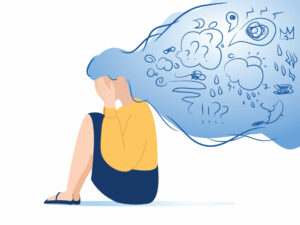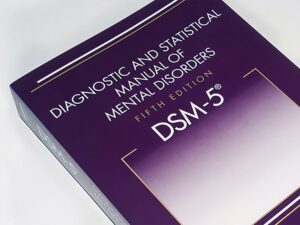Acute stress disorder DSM 5 is a mental health condition that can occur after someone has been through a traumatic event. It can cause intense fear, helplessness, or horror. If you are experiencing these symptoms, it is important to get help. In this blog post, we will discuss what acute stress disorder DSM 5 is, and how you can get help for yourself or someone you know.
Contents
What Are Acute Stress Disorders?

Acute stress disorders (ASD) are a type of mental illness. They can happen after you experience a traumatic event. A traumatic event is something horrible and scary that you see, hear about, or that happens to you. ASD can make it hard for you to go on with your life after the event.
ASD can happen to anyone. It is more common in women than men. It is also more common in people who have had other mental health problems in the past such as anxiety or depression. People who have post-traumatic stress disorder (PTSD) are also at risk for ASD.
If you have ASD, you may feel like you’re in danger even when you’re not. You may be constantly on guard and always alert. You may have trouble sleeping and concentrating. Sometimes You may feel numb, or you may not be able to feel anything at all. You may also have flashbacks of the event. These are called intrusive memories. They can happen at any time, even when you’re doing something else.
How To Diagnose Acute Stress Disorders?
Diagnosing an acute stress disorder usually involves a mental health professional asking you questions about your symptoms and experiences. They may also perform a physical exam to rule out other conditions.
To be diagnosed with an acute stress disorder, you must have:
- Experienced or witnessed a traumatic event
- Felt intense fear, helplessness, or horror during the event
- Three or more of the following symptoms start within one month of the event:
- Re-experiencing the trauma through flashbacks or nightmares
- Avoiding things that remind you of the trauma
- Negative changes in your thoughts and feelings
- You may feel numb, detached from others, or have trouble remembering details about the event
- Difficulty sleeping or concentrating
- You may be easily startled or have an exaggerated startle reflex
- Also, You may experience irritability, outbursts of anger, or aggression
- You may feel like you’re always on guard for danger
Another method to diagnose it is using DSM-5, which is the most recent edition of the Diagnostic and Statistical Manual of Mental Disorders.
The DSM-IV was released in 1994 and included PTSD as a diagnosis. The DSM-V, published in 2013, included changes to the definition of PTSD and added Acute Stress Disorder as its diagnosis.
What Is DSM-5?

DSM-5 is the fifth edition of the Diagnostic and Statistical Manual of Mental Disorders (DSM). It’s published by the American Psychiatric Association (APA) and provides a common language and criteria for the classification of mental disorders.
DSM-IV, published in 1994, was the first major revision of DSM since its publication in 1952. DSM-IV introduced several new disorders, including Asperger syndrome, conduct disorder, oppositional defiant disorder, and Tourette syndrome. It also included significant changes to existing disorders, such as attention deficit hyperactivity disorder (ADHD), autism spectrum disorder, bipolar disorder, and schizophrenia.
In May 2013, the APA released DSM-V, which made several changes to disorders and introduced new ones. The most significant changes in DSM-V were to the disorders themselves, rather than the way they were organized or listed.
Different Criteria of Acute Stress Disorder DSM 5
There are different types of Acute Stress Disorder DSM-IV. The first type is called With Dissociation and the second is Without Dissociation. To be diagnosed with Acute Stress Disorder DSM-IV, you must have all of the following:
Exposure to a traumatic event in which both of the following were present:
The person experienced, witnessed, or was confronted with an event or events that involved actual or threatened death or serious injury, or a threat to the physical integrity of self or others
The person’s response involved intense fear, helplessness, or horror. Note: If children are age six years old or younger, they may exhibit disorganized attachment behaviors instead of fear and helplessness;
B The development of three (or more) of the following dissociative symptoms beginning after the traumatic event(s) occurred.
A numbing of general responsiveness (not present before the trauma), as indicated by three or more of the following:
Marked reduction in effect; e.g., unable to have loving feelings.
Feeling detached from others and events.
Sense of a limited future, e.g., does not expect to have a career, marriage, children, etc.
C The individual experiences at least one symptom from Criterion A that persists for more than one month after the exposure to trauma.”;
D The disturbance causes clinically significant distress or impairment in social, occupational, or other important areas of functioning.
E The disturbance is not attributable to the physiological effects of a substance (e.g., medication, alcohol) or another medical condition.”;
If you have experienced a traumatic event and are displaying any of the above symptoms, it is important to seek help from a mental health professional. They will be able to assess whether or not you meet the criteria for Acute Stress Disorder and provide you with the necessary treatment.
Treatment According To Acute Stress Disorder DSM 5

The treatments for acute stress disorder according to the DSM-V are:
Cognitive behavioral therapy – This is a type of talk therapy that can help you process your thoughts and feelings about the traumatic event. It can also help you learn new coping skills. In this type of therapy, you work with a therapist in weekly sessions.
Exposure therapy – This is a type of cognitive behavioral therapy. In exposure therapy, you talk about your traumatic experience in detail with your therapist. You may also be asked to do things that remind you of the trauma, such as looking at pictures or watching videos. This can help you work through your feelings about the event.
Medication – You may be prescribed medication to help with symptoms of anxiety or depression. Medication can help reduce symptoms so that you can participate in other forms of treatment, such as exposure therapy. These medications are called antidepressants.
Support Groups: There are many support groups available to help people who have PTSD. These groups provide a place to talk about your experiences and feelings with others who understand what you are going through. They can also be a great source of support and information.
Self-Care: Some people find that self-care can help with symptoms of PTSD. This can include things like exercise, relaxation techniques, and healthy eating. Taking care of yourself can help you feel better and make it easier to cope with stress.
Acute stress disorder is a serious condition that requires treatment. If you think you may have ASD, please reach out for help from a mental health professional. There is no shame in seeking help, and treatment can make a big difference in your life.
Conclusion
Acute stress disorder is a real and debilitating condition that can have lasting effects. If you think you may be suffering from ASD, please reach out to a mental health professional for help. With treatment, it is possible to recover and live a healthy, happy life.
In DSM-5, acute stress disorder is classified as a dissociative disorder, and its symptoms must be present for at least six days to make a diagnosis. There are several treatment options available for ASD, and the most effective approach will likely vary from person to person.
Psychotherapy, medication, and self-care strategies can all help manage ASD symptoms. If you or someone you know is struggling with acute stress disorder, please seek professional help. Recovery is possible with the right treatment and support.
Hope this article was of help to you! If you are suffering from anxiety attacks, you may seek help from Therapy Mantra. We have a team of highly trained and experienced therapists who can provide you with the tools and skills necessary for overcoming anxiety attacks. Contact us today to schedule an online therapy or download our free Android or iOS app for more information.


